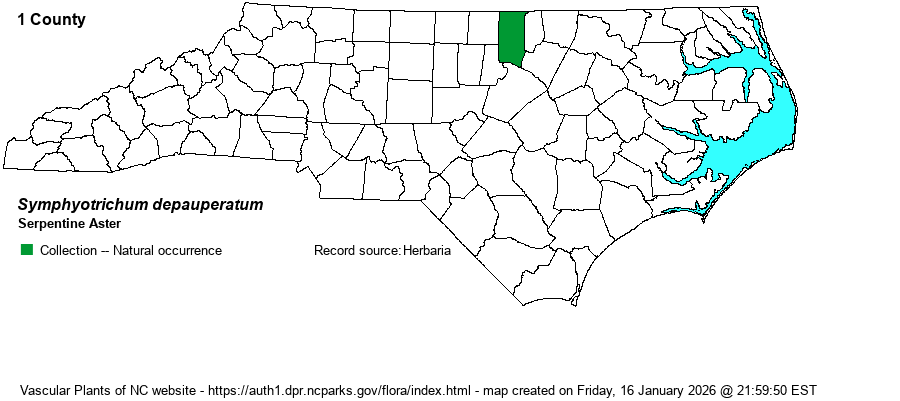| Author | (Fernald) G.L. Nesom | |
| Distribution | This species has been batted around from one taxon to another in recent decades, often considered as S. parviceps, but that is considered to be a Midwestern species of prairies. Northeastern Piedmont only. Found only in Granville County, where confined to diabase barrens at Picture Creek and vicinity, all on the Durham Diabase Sill. Reported for NC by Levy and Wilbur (1990); specimens can be traced back to 1979.
Serpentine barrens in southeastern PA and central MD; disjunct to NC. A very limited range, in the lower Piedmont -- not yet confirmed in VA. | |
| Abundance | Known from about 6 sites within a few miles of Butner in southwestern Granville County. Can be locally common to abundant, with hundreds of plants at a few sites. This is a State Endangered species. | |
| Habitat | Open to semi-forested diabase glades and barrens. Several populations are in powerline clearings and roadsides, but all populations are on high pH soil, over diabase rock. |
| Phenology | Flowering and fruiting September-October. | |
| Identification | Serpentine Aster is a small and delicate aster, growing just 1-2 feet tall, often several stems together or in colonial patches. Basal leaves are absent at flowering time, and some stem leaves are withering; stem leaves are lance-shaped, stalkless, up to 1.5 inches long. The inflorescence occupies half of the plant height, with many spreading to ascending branches, abundant tiny bracts, and many small heads with tiny white rays. It may resemble small examples of some of our other white-flowered asters, including the usually pale-blue flowered S. dumosum, but the location (Granville County thus far) and glade/barrens habitat should separate it. | |
| Taxonomic Comments | NOTE: The genus Aster was examined by G.L. Nesom (1994), who determined that it was composed of a number of discrete genera (a few of which were already split off by authors as Sericocarpus, Ionactis, etc.). The earliest available name for North American "Aster" is Symphyotrichum, a name regrettably long and hard to spell.
Serpentine Aster is an eastern representative of the midwestern S. parviceps.
| |
| Other Common Name(s) | None | |
| State Rank | S1 | |
| Global Rank | G2 | |
| State Status | E | |
| US Status | | |
| USACE-agcp | | |
| USACE-emp | | |

